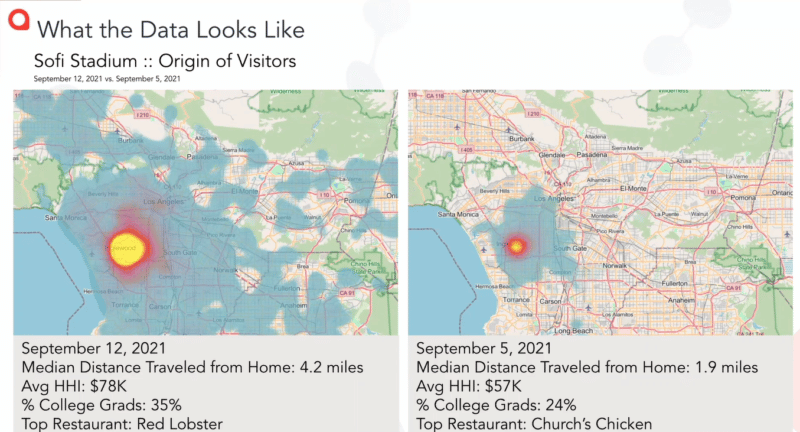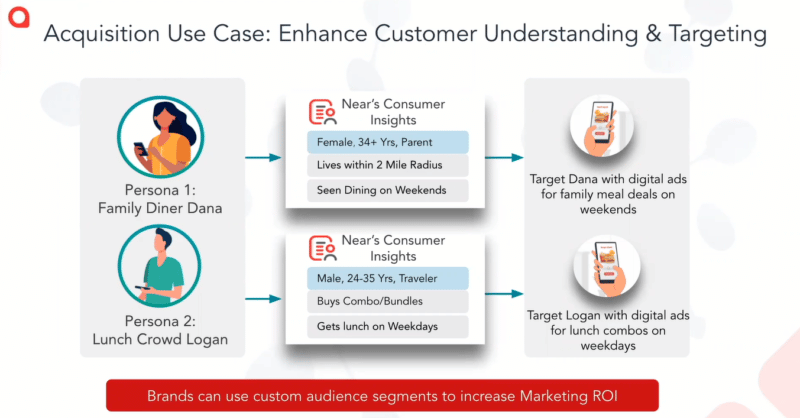Marketers can use location data to find new customer insights and improve ROI.
Marketers continue to use location-based data to boost campaigns and customer acquisition in retail and other industries. Even though many consumers buy products and services online through e-commerce channels, they also like to get out and visit store sites.
“A lot of money and a lot of time and resources are going into attracting the consumer to come to different retail locations,” said Charm Bianchini, senior director, demand generation and field marketing for location intelligence company Near, at The MarTech Conference.
In many cases, meeting customers where they are means understanding how close they could be to a physical store.
“Human movement data can improve your targeting, which then increases your ROI,” said Bianchini.
Where location data comes from
Location-based data — or human movement data, as the Near people call it — is gathered primarily from mobile apps.
Popular games like Zynga’s Words with Friends will ask players to consent to share location data under terms that allow that data to be used in campaigns.
For marketers, location data is third-party data that gives insights into traffic patterns in a region, city or neighborhood. Identity resolution tools can also be used to add additional layers of data to the consumers in that traffic.
Interpreting location data for marketing campaigns
Here’s an example of location data taken from two different events, one week apart, at Sofi Stadium in Los Angeles.

It’s apparent from the location-based data and other consumer intelligence that the event on the right was a smaller, local event. The following week, depicted on the left, was larger and attracted visitors from farther away.
Household income data and consumer preferences can help inform marketers for specific brands
“If you’re a restaurant, for example, you could use this to your advantage,” said Bianchini. “If you’re Red Lobster and you know that people are coming to your location, why not offer some of your loyal customers some sort of discount? Or if you know that everyone’s going to Church’s Chicken, you might want to offer a promotion to come to KFC.”
She added, “This is the power of human movement data and really being able to access real-time information on what’s going on with people.”
Using location data for customer acquisition
Marketers can use digital channels to act on location data. They can connect with loyal customers through digital billboard ads when the data indicates that they are close to a specific site.
Also, if it’s known that a customer was at a store location, marketers can follow up with special offers to bring them back another time, or to buy something if they didn’t purchase a product on their previous visit.
Marketers can also make an attempt to attract customers who visited a competitor.
Enhancing first-party data and expanding campaigns
If your brand already has first-party data in customer profiles, they can be enhanced by location data. The location data for customers at a restaurant, for instance, can provide insights into when they visit and from how far away. This data is then merged with other first-party insights you might have about the customer, including demographics, purchases and other preferences.

Marketers then make a persona out of these customers to build out a strategy on how to reach them through a given channel, and at a certain time. If they visit on the weekends, they could be sent a mobile ad or email during the weekend about a specific deal that matches their interests.
Knowing more about these location-based patterns will increase efficiency for campaigns and boost ROI, according to Bianchini. By serving relevant, helpful ads, they can also build customer relationships and increase customer lifetime value.
Advancing digital marketing with human movement data from Third Door Media on Vimeo.
The post How location data helps marketers acquire new customers and expand campaigns appeared first on MarTech.
(17)









